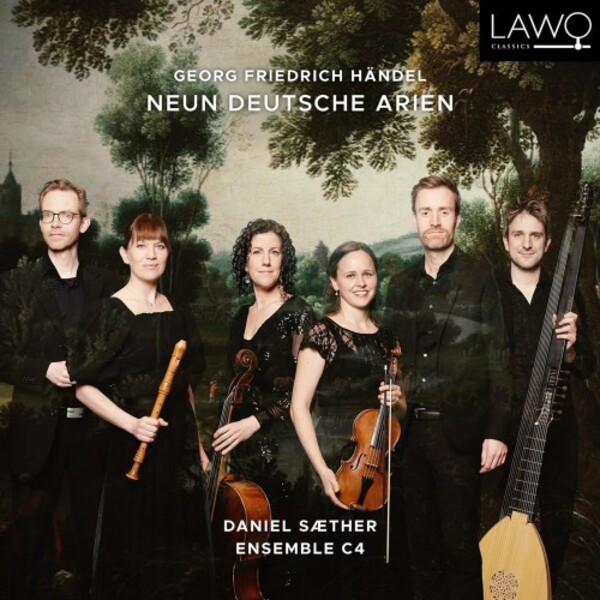HANDEL Neun Deutsche Arien (Daniel Saether)
View record and artist detailsRecord and Artist Details
Genre:
Vocal
Label: Lawo
Magazine Review Date: 04/2024
Media Format: CD or Download
Media Runtime: 56
Mastering:
DDD
Catalogue Number: LWC1269

Tracks:
| Composition | Artist Credit |
|---|---|
| German Arias |
George Frideric Handel, Composer
Daniel Sæther, Countertenor Ensemble C4 |
| (12) Trio Sonatas for 2 Violins and Continuo, Movement: No. 12 in D minor, Variations on 'La Follia', RV63 |
Antonio Vivaldi, Composer
Ensemble C4 |
Author: Edward Breen
Already well represented on disc and regularly reviewed in these pages, Handel’s Nine German Arias need little introduction save for a reminder that there is evidence to date them in the 1720s, somewhere among that glittering trio of operatic masterpieces Julius Caesar, Tamerlano and Rodelinda. For my own tastes, I have a mild preference for a more introspective performance style in these German arias (as well as in Handel’s Italian cantatas). I enjoy the sensation of eavesdropping rather than being performed at. For this reason I gravitate towards light voices: Emma Kirkby’s shimmering 1985 LP with London Baroque (Erato, 9/86), Monika Mauch’s intimate precision (Carus, 5/09) and Carolyn Sampson’s warm charm (Hyperion, 7/07).
These pieces were soprano territory until Iestyn Davies’s account (Wigmore Hall Live, A/10), so it’s a delight to hear a relatively new voice, Norwegian countertenor Daniel Sæther, and welcome the recording debut of Oslo-based Ensemble C4. There is much to enjoy here as they have clearly grasped the essence of Handel’s settings of Barthold Heinrich Brockes’s Enlightenment poetry in pared-back style, and they play with confident precision as the (unnamed) obbligato part is shared between the two regular members of C4.
‘Künft’ger Zeiten eitler Kummer’ (‘Vain concerns for the future’) uses recorder and I love recorder-player Caroline Eidsten Dahl’s husky, woody tone, which makes an interesting counterpart to Sæther’s focused and citrusy falsetto – there’s no denying that his voice is a stunning instrument – but in both cases I would prefer more legato line. I prefer this aria characterised by ‘gentle slumber’ (‘sanften Schlummer’) and this performance is a bit fidgety for that: the fluttering of eyelids during slumber, perhaps?
In ‘Das zitternde Glänzen der spielenden Wellen’ (‘The shimmering gleam of dancing waves’), Ingrid Økland’s violin is indeed shimmering and dancing, especially in the B section. It’s not as fast as others and taps into a sense of serenity that I adore. Similarly, ‘Süsse Stille, sanfte Quelle’ (‘Sweet quiet, gentle source’) immediately captures an atmosphere of ‘peaceful serenity’ in a warm and passionate performance and is quite my favourite on this album. I find the crucial sense of spring frivolity is too subtle at the start of ‘Meine Seele hört im Sehen’ (‘My soul hears, through seeing’). Similarly in the majestic ‘Die ihr aus dunklen Grüften’ (‘You who from dark vaults’), which is surely a distant cousin of the twin arias ‘Va tacito’ and ‘Camminando lei pian piano’, although one could argue for more contrast at ‘Sprecht nicht: es ist nur Farb und Schein’ (‘Do not say: it’s merely light and colour’).
Having said all that, this is a superb recording and a strong debut for Ensemble C4. It’s characterised by the voice of Daniel Sæther: sure-footed, stylish and confident. There’s a bright future ahead for these musicians, I’m sure.
Explore the world’s largest classical music catalogue on Apple Music Classical.
Included with an Apple Music subscription. Download now.

Gramophone Digital Club
- Digital Edition
- Digital Archive
- Reviews Database
- Full website access
From £8.75 / month
Subscribe
Gramophone Full Club
- Print Edition
- Digital Edition
- Digital Archive
- Reviews Database
- Full website access
From £11.00 / month
Subscribe
If you are a library, university or other organisation that would be interested in an institutional subscription to Gramophone please click here for further information.




